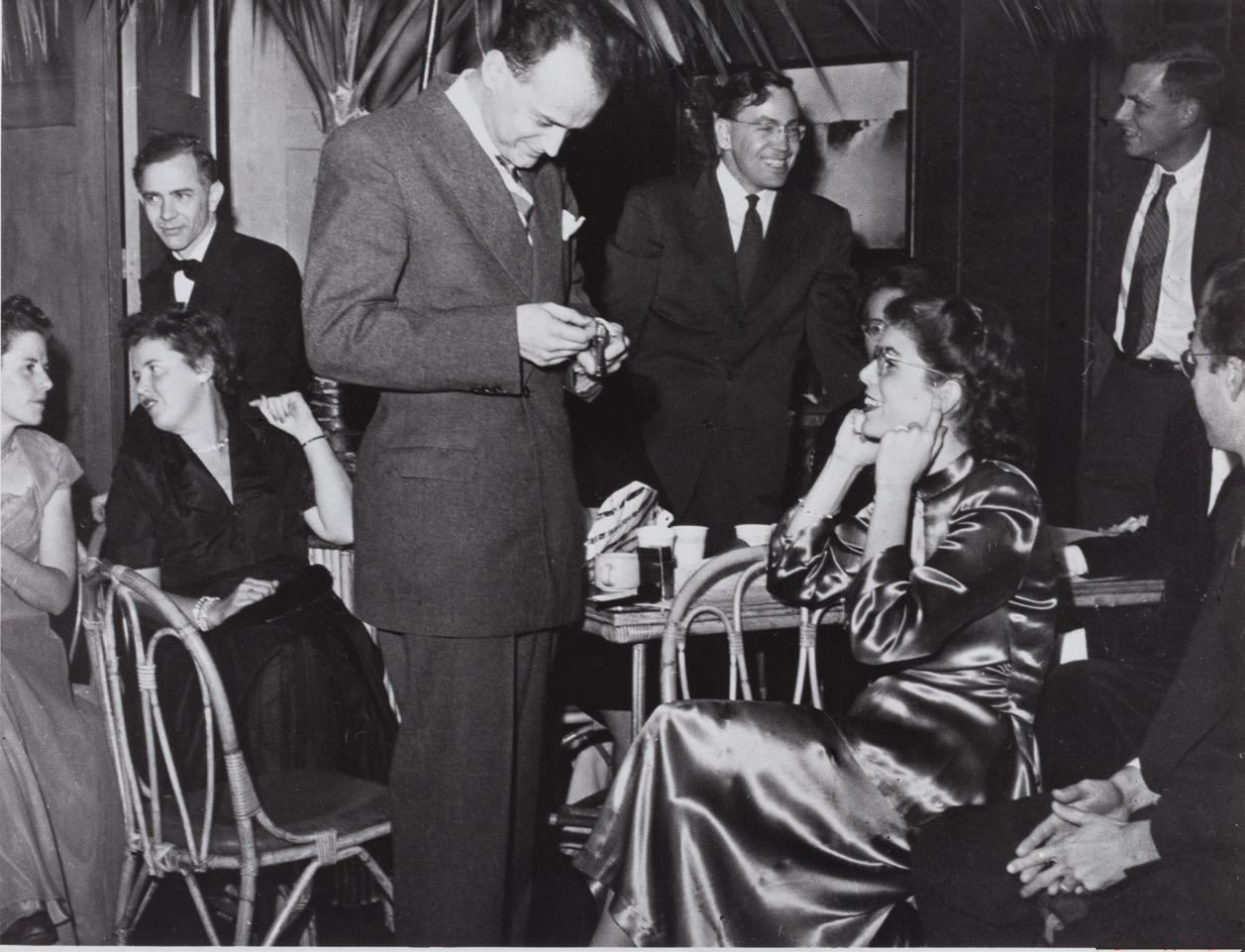
9 minute read
75 YEARS OF CHEMICAL ENGINEERING AT BERKELEY

BY C. JUDSON KING
Advertisement
2022 is not only the 150th anniversary of the College of Chemistry, but also the 75th anniversary of the start of the chemical engineering program at Berkeley. Although the 75-year-old program is half the age of the College, it is still relatively young as chemical engineering programs go. Programs at most other universities were formed earlier in the twentieth century or even at the end of the nineteenth. The American Institute of Chemical Engineers traces back to 1908.
The chemical engineering program that has thrived at Berkeley is a product of its times. The Allies in World War II had derived considerable advantage from several highly technical war-related projects, most notably the development of radar and the Manhattan Project for the atomic bomb in the United States and the development of the proximity fuse in the United Kingdom. These engineering projects had been carried out largely by scientists because there was a growing belief that the education of the engineers in that era did not contain sufficient science and math for them to contribute well to such rapid and innovative advances. This view set off a national wave to remedy the situation.
When the establishment of a full program in chemical engineering was explored seriously in 1945, both the College of Chemistry and the College of Engineering were interested and made competing proposals. Chemistry faculty member Joel Hildebrand was a longtime member of the Academic Senate’s Committee on Budget and Interdepartmental Relations. He argued that the need for more science and mathematics was a cogent reason for placing chemical engineering within the College of Chemistry, and that rationale carried the



day with both the Academic Senate and Provost Monroe Deutsch. Instruction in chemical engineering began in the College of Chemistry in the Fall of 1946.
For the better part of a decade, the College of Engineering maintained a competing program under the name Process Engineering. The matter was finally resolved when Clark Kerr, in 1952, became Berkeley’s first chancellor. Kerr set up a systematic review process and ultimately decided in favor of the College of Chemistry. Thus, Chemical Engineering became a separate Department in 1957. In his 2001 memoirs, Kerr stated “I decided to leave chemical engineering in the College of Chemistry where it had an outstanding record and where its faculty members were very satisfied. Chemistry was a ‘college’, not a department, as it remains to this day. It has been, and still is, in my judgment, the outstanding unit within the University of California – superb in research, superb in the teaching of both undergraduate and graduate students, and superb in the contributions of its faculty to university governance.” No small praise!
The department’s founding faculty members were highly capable and achieved much distinction, raising the department to high national standing by the time of the 1966 reputational survey of the American Council on Education. Three of the early faculty members (Charles Wilke, LeRoy Bromley, and John Prausnitz) received the Allan P. Colburn Award of the American Institute of Chemical Engineers (AIChE) during the period 1951-1962. The AIChE William H. Walker Award went to Charles Wilke, John Prausnitz, Theodore Vermeulen, and Judson King during the period 1965-1976. Nineteen faculty members of the department have so far become members of the National Academy of Engineering, including two of the department’s founding five.
Chemical Engineering as a field had originally been created to provide for the engineering needs of the petroleum and heavy chemical industries. At Berkeley, the approach has to a much greater degree been to seek the places where fundamental engineering principles are useful for applications of chemistry, without any limitations regarding what specific industries, products, or processes are involved. This more general approach was continually and strongly advocated for by Charles Tobias from the beginning of the department onward. The Berkeley program has therefore been a leader in instituting and fostering newer applications of chemical engineering, something that is now reflected in most academic chemical engineering programs nationwide and worldwide. The focus on instituting and fostering newer applications has been a healthy trend for the profession of chemical engineering as well, expanding the job market and leveling out the ups and downs in a market that was historically attached to the economic circumstances of the petroleum, petrochemical, and chemical industries. Two prime examples – electrochemical engineering and biomolecular engineering – illustrate the ways in which Berkeley chemical engineering helped to make this transition.
Charles Tobias, one of the original five faculty members, came to Berkeley in 1947 as an émigré from Hungary to join his brother Cornelius, who worked with Ernest Lawrence’s brother John in medical physics at Berkeley Lab. Upon his arrival, he sought out Wendell Latimer who was then dean of the College. Seizing upon the fact that Tobias had worked as a chemical engineer in the United Incandescent Lamp and Electrochemical Company in Hungary, Latimer urged him to start a program in electrochemical engineering at Berkeley. That is precisely what Tobias did, building what was to become the preeminent electrochemical engineering program in the United States, with




graduates founding similar programs across the nation and world. In 2019, the Nobel Prize for Chemistry was given for the development of lithium-ion batteries. The report from the Nobel committee on scientific background for that prize cited the 1958 Ph.D. dissertation of William S. Harris, supervised by Tobias, on the use of propylene carbonate and related solvents as being crucial for the development of those now-workhorse batteries. That report also cites the theoretical contributions of Berkeley faculty member John Newman.
Berkeley chemical engineering has continued to be a world leader in the field as batteries have become more and more important for electric cars, leveling energy loads, and powering mobile devices of all sorts and sizes. Berkeley chemical engineering faculty member Elton Cairns devoted his entire academic career to research on batteries and fuel cells. Nitash Balsara has developed novel and improved electrolytes for lithium-ion batteries, and, most recently, Bryan McCloskey has characterized fundamental electrochemistry occurring at multi-phase interfaces to provide design insight for energy storage, electrocatalysis, and corrosion-resistant materials.
About 1967, Charles Wilke, another of the original five faculty members, who at the time stood at the top of his field of mass transfer, made the striking decision to switch his research efforts completely to the nascent field of biochemical engineering. This was a remarkably foresighted move, as the biotech industry evolved rapidly in the late 1970s and early 1980s based on scientific advances in recombinant DNA and other molecular-based scientific advances, with the San Francisco Bay area becoming an industrial powerhouse. Subsequent faculty additions in the area through 2010 included Harvey Blanch, Douglas Clark, Jay Keasling, David Schaffer, and Wenjun Zhang, covering a variety of areas in bioprocessing, synthesis of new and natural molecules, bio-separations, enzyme engineering, and biomedical applications. Research in these areas has been one of the principal ways in which the capabilities of science and engineering departments on the campus have been brought together synergistically. Keasling has achieved major recognition for the synthetic production of artemisinin, the major drug for the treatment of malaria.
Remarkably, the first four (counting Wilke) faculty members involved with biochemical and biomolecular engineering are all now members of the National Academy of Engineering, and the number will surely increase. Between them, Keasling and Schaffer have been involved in launching eight new companies so far. In 2022, Schaffer has taken on the role of Director of the Bakar BioEnginuity Hub, a joint activity of the Berkeley and San Francisco campuses located at Berkeley and devoted to entrepreneurial development of products of biological and biomedical research. Because of the growth in this area, the name of the Chemical Engineering department was changed in 2010 to Chemical and Biomolecular Engineering. Also, more women chemical engineering faculty continue to join the department with the most recent additions of Markita Landry (nanomaterials and molecular engineering), Michelle Chang (biochemistry, chemical biology, and synthetic biology), and Joelle Frechette (soft materials, interfacial science, and adhesion).
In 2018 Frances Arnold (Ph.D.’85, ChemE) who studied with Harvey Blanch, was awarded the Nobel Prize in Chemistry for her original work in directed evolution of organisms. She was the fourth woman, and only the second chemical engineer to receive that award.
This article is based on Professor King’s 2020 book, A History of Berkeley Chemical Engineering: Pairing Engineering and Science, which is available both in print from Amazon and as an open-access download at https://escholarship.org/uc/item/000395px.
HHISTORICAL LIST OF TENURE TRACK
CHEMICAL ENGINEERING FACULTY


Pages 18-19
Student in process engineering lab.
PHOTO DENNIS GALLOWAY CIRCA 1980S
Chemical Engineer students Bryan Rogers (’71) and Peter Cukor (’71) protest against the Vietnam war.
PHOTOGRAPHER UNKNOWN CIRCA 1970
Student with slide-rule.
PHOTO DENNIS GALLOWAY CIRCA 1980S
Wanda Clearwaters, first woman member of the Chemical Engineering club.
PHOTOGRAPHER UNKNOWN CIRCA 1963
Pages 20-21
Chemists, chemical engineers and their wives at a party. Charles Tobias is about to shoot off a cap gun. (Left group) seated Mary Ellen Powell and Jean Pitzer; standing Dick Powell (Center group) Charles Tobias (l) and Bill Gwinn (r) (seated) Laura Lee McClure; (Right group) standing Ken Pitzer; seated Don McClure.
PHOTOGRAPHER UNKNOWN CIRCA 1949-1955
(l to r) Charles Tobias, F. Campbell Williams, and Donald Hanson.
UNKNOWN PHOTOGRAPHER AND DATE
Charles Wilke, one of the first faculty in the department of Chemical Engineering (1946), department chair 1957-1963.
PHOTO DENNIS GALLOWAY, DATE UNKNOWN 1946 Philip Schutz
LeRoy Bromley Theodore Vermeulen Charles Wilke
chair 1957–1963 1947 Donald Hanson chair 1963–1967
Charles Tobias
chair 1967–1972 1948 Campbell Williams 1952 Kenneth Gordon 1953 Eugene Petersen 1954 Andreas Acrivos 1955 John Prausnitz 1958 Don Olander 1961 Michel Boudart
Alan Foss Richard Wallace
1962 Simon Goren chair 1994–1997 1963 Edward Grens
John Newman Judson King
chair 1972–1981
Richard Ayen
1964 Robert Merrill 1965 David Lyon
Michael Williams
1966 Robert Pigford 1967 Scott Lynn
Alexis Bell
chair 1981–91; interim chair 2005–06 1969 Mitchell Shen 1970 Thomas Sherwood
Lee Donaghey
1975 Clayton Radke 1977 Dennis Hess 1978 Elton Cairns
Harvey Blanch
chair, 1997–2001 1979 David Soane
Edward Reiff
1981 Morton Denn chair 1991–94 1982 Jeffrey Reimer chair 2006–2011; 2013 –2015; 2016–2022 1983 Jim Michaels 1986 Douglas Clark chair 2011–2013
David Graves Doros Theodorou
1988 Arup Chakraborty chair 2001–2005 1991 Susan Muller 1992 Jay Keasling 1993 Enrique Iglesia
Roya Maboudian
1999 David Schaffer 2000 Alexander Katz
Nitash Balsara
2004 Rachel Segalman 2006 Jhih-Wei Chu 2007 Berend Smit 2008 Keith Alexander 2009 Danielle Tullman-Ercek 2011 Wenjung Zhang 2013 Bryan McCloskey chair 2022–2014 Ali Mesbah 2016 Markita Landry
Kranthi Mandadapu
2019 Rui Wang 2020 Karthik Shekhar 2021 Joelle Frechette










